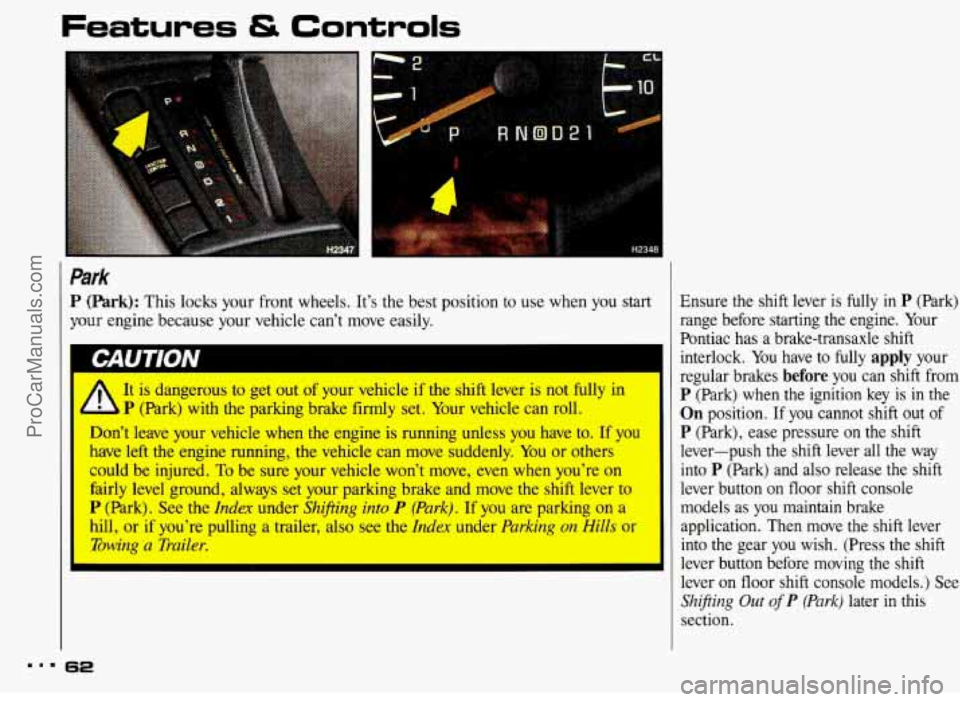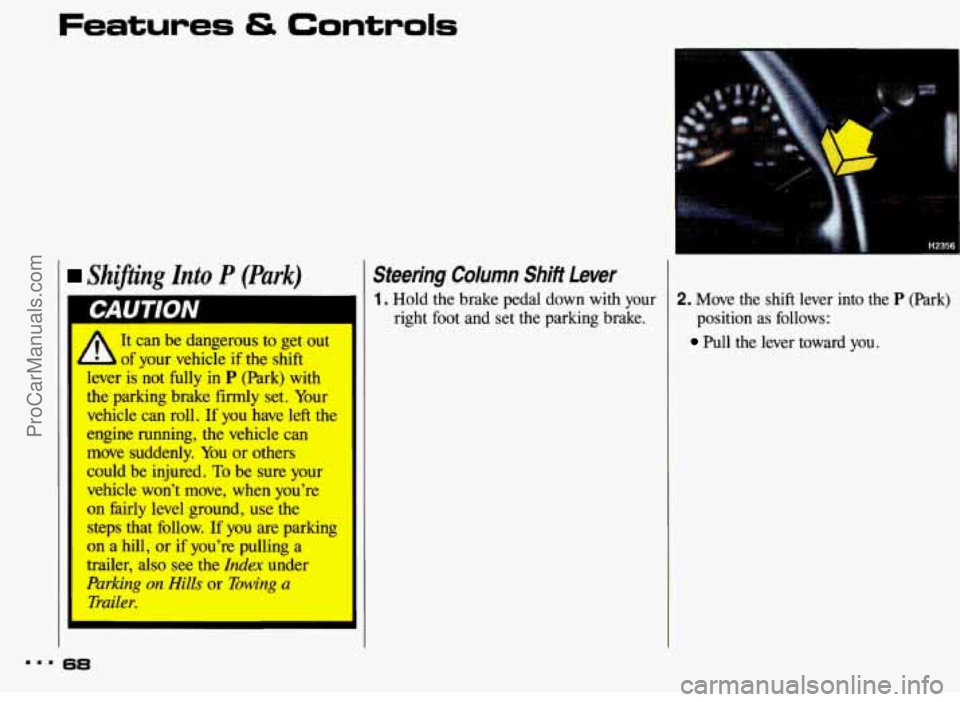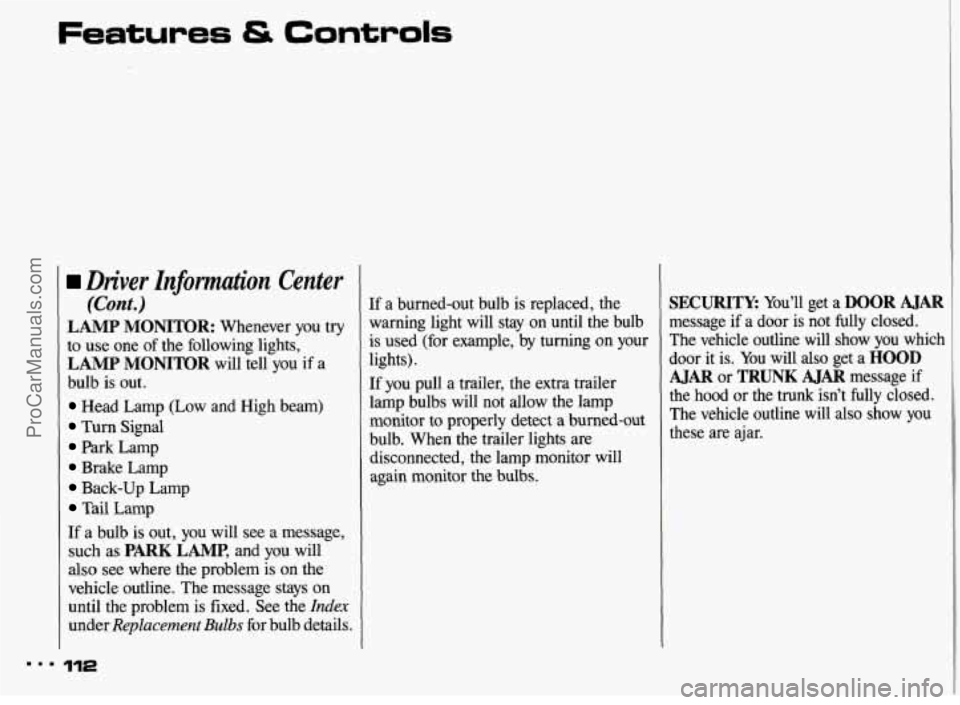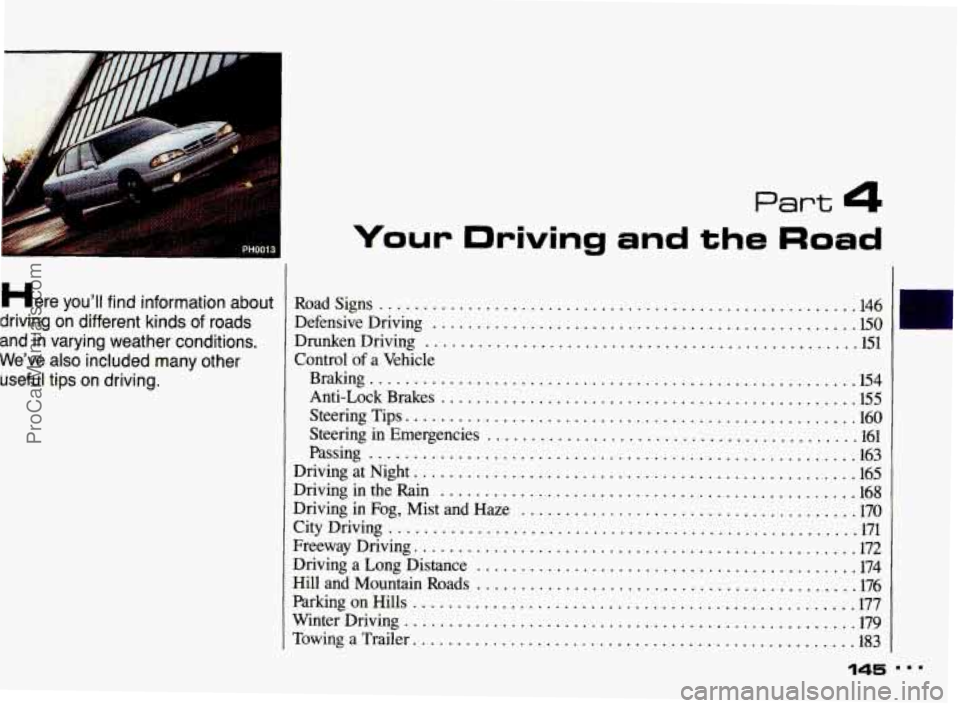1993 PONTIAC BONNEVILLE trailer
[x] Cancel search: trailerPage 63 of 322

5 & Controls
Park
P (Park): This locks your front wheels. It’s the best position to use when you start
your engine because your vehicle can’t move easily.
1 It is dangerous to get out of your vehicle if the shift lever is not my in
Don’t leave your vehicle when the engine is running unless you have to. If you
have left the engine running, the vehicle can move suddenly. You or others
could be injured. To be sure your vehicIe won’t move, even when you’re on
fkirly level ground, always set your parking brake and move the shift lever to
P (Fark). See the Inda under Shiping into P (Park). If you are parking on a
hill, or if you’re pulling a trailer, also see the Inda under Parking on HilZs or
Towing a llailer.
- P (park) with the parking brake firmly set. Your vehicle can roll.
Ensure the shift lever is fully in P (Park)
range before starting the engine. Your
Pontiac has a brake-transaxle shift
interlock. You have to fully
apply your
regular brakes
before you can shift from
P (Park) when the ignition key is in the
On position. If you cannot shift out of
P (Park), ease pressure on the shift
lever-push the shift lever all the way into
P (Park) and also release the shift
lever button
on floor shift console
models as you maintain brake
application. Then move the shift lever
into the gear you wish. (Press the shift
lever button before moving the shift
lever on floor shift console models.) See
Shifting Out of P (Park} later in this
section.
I.. 62
ProCarManuals.com
Page 66 of 322

If your vehicle seems to start up
rather slowly, or if it seems not to
shift gears
as you go faster,
something may be wrong with a
transaxle system sensor. If you
drive very far that way, your
vehicle can be damaged.
So, if this
happens, have your vehicle
serviced right away. Until
then,
you can use 2 (Second Gear) when
vou are driving less than
35 mDh
i56 km/h) anza (0
higher speeds.
D (Third Gear): This is like , but
you never go into Overdrive. Here are
some times you might choose
D instead
When driving on hilly, winding roads.
When towing a trailer, so there is less
When going down a steep hill.
2 (Second Gear): This position gives
you more power but lower fuel
economy.
You can use 2 on hills. It can
help control your speed as you go down
steep mountain roads, but then you
would also want to use your brakes
off
and on.
ofm:
shifting between gears.
r
Don't drive in 2 (Second Gear) for I
more than 5 miles (8 km), or at
speeds over
55 mph (88 km/h), or
you
can damage your transaxle. Use
or
D as much as possible.
Don't shift into
2 unless you are
going slower than
65 mph
(105 km/h), or you can damage
your engine.
65 mmm
ProCarManuals.com
Page 68 of 322

L-
Parking Brake
To Set the Parking Brake:
Hold the regular brake pedal down with
your right foot. Push down the parking
brake pedal with
your left foot. If the
ignition
is on, the brake system warning
light will come on.
A chime will sound
after the vehicle has traveled
46 feet
(14 meters),
To Release the Parking Brake:
Hold the regular brake pedal down. Pull
the
BRAKE RELEASE lever. If you
try to drive off with the parking brake
on, the brake light stays on and a chime
sounds until you release the parking
brake or recycle the ignition.
If You are on a Hill:
See the Index under Parking on Hitls.
That section shows how to turn your
front wheels.
If You are Towing a Trailer and are
Parking on
Any Hill:
See the Index under Towing a Trailer.
That section shows what to do first to
keep the trailer from moving.
67
c
...
ProCarManuals.com
Page 69 of 322

Features & Controls
1 Shifting Znto P (Park)
It can be dangerous to get out
~ b of your vehicle if the shift
lever is not fully
in P (Park) with
the parking brake firmly set. Your
vehicle can roll.
If you have left the
engine running, the vehicle can
move suddenly. You or others
could be injured.
To be sure your
vehicle won’t move, when you’re
on fairly level ground, use the
steps that follow. If you are parking
on a hill, or if you’re pulling a
trailer, also see the
Index under
rking on Hills or Towing a
rrailer.
Steering Column Shift Lever
1. Hold the brake pedal down with your
right foot and set the parking brake. 2. Move the shift lever into the P (Park)
position as follows:
Pull the lever toward you.
68
ProCarManuals.com
Page 73 of 322

Features & Controls
Running Your Engine While You’re Parked
It’s better not to park with the engine running. But if you ever have to, here are
I some things to know.
II Idling the engine with the air system control OFF could allow dangerous
xhaust
into your vehicle (see the earlier CAUTION under Engine Exhaust). ‘
so, idling in a closed-in place can let deadly carbon monoxide (CO) into
your vehicle even
if the fan switch is at the highest setting. One place this can
happen is a garage. Exhaust-with CO-can come
in easily. Never park in a
garage
with the engine running.
Another closed-in place can be a blizzard. (See
the Index under Bliaard.)
It can be dangerous to get out of your vehicle if the shift lever is not fully in
P (Park) with the parking brake firmly set. Your vehicle can roll. Don’t leave
your vehicle when the engine is running unless you have to. If you’ve
left the
engine running, the vehicle can move suddenly. You or others could be
injured.
To be sure your vehicle won’t move, even when you’re on fairly level\
ground, always set your parking brake and move
the shift lever to P (Park).
If you are parking on a hill, or if you’re pulling a trailer, also see the Zndex
under Parking on Hills or Towing a Truik
rn.1 72
Horn
You can sound the horn by pressing the
horn
symbols on your steering wheel,
ProCarManuals.com
Page 75 of 322

Features & Controls
Turn Signal and Lane Change
Indicator
The turn signal has two upward (for
Right) and two downward (for Left)
positions. These positions allow you to
signal a turn or a lane change.
To signal a turn, move the lever all the
way up or down. When the turn is
finished, the lever will return
automatically.
A green arrow on the instrument panel
will flash in the direction of the turn or
lane change.
To signal a lane change, just raise or
lower the lever until the green arrow
starts to flash. Hold it there until you
complete your lane change. The lever
will return by itself when you release
it.
As you signal a turn or a lane change, if
the arrows don’t flash but just stay
on, a
signal bulb may be burned out and other
drivers won’t see your turn signal.
If you
have the Driver Information Center, it
will tell you if you have a burned out
bulb. See the
Index under Driver
Information
Center.
If a bulb is burned out, replace it to help
avoid an accident.
If the green arrows
don’t go on at all when you signal a
turn, check the fuse (see the
Index under
Fuses & Circuit Breakers) and for
burned-out bulbs.
If you have a trailer towing option with
added wiring for the trailer lights, a
different
turn signal flasher is used.
With this flasher installed, the signal
indicator will flash even if a
turn signal
bulb is burned out. Check the front and
rear turn signal lights regularly to make
sure they are working.
... 74
.. c L ProCarManuals.com
Page 113 of 322

Features & Controls
Diver Information Center
(Cont.)
LAMP MONITOR: Whenever you try
to use one of the following lights,
LAMP MONITOR will tell you if a
bulb is out.
Head Lamp (Low and High beam)
Turn Signal
Park Lamp
Brake Lamp
Back-up Lamp
Tail Lamp
If
a bulb is out, you will see a message,
such as PARK LAMP, and you will
also see where the problem is on the
vehicle outline. The message
stays on
until the problem is fixed. See the
Index
under Replacement Bulbs for bulb details.
112 mmm
If a burned-out bulb is replaced, the
warning light will stay on until the bulb
is used (for example, by turning on your
lights).
If you pull a trailer, the extra trailer
lamp bulbs will not allow the lamp
monitor to properly detect a burned-out
bulb. When the trailer lights are
disconnected, the lamp monitor will
again monitor the bulbs.
SECURITY You’ll get a DOOR AJAR
message if a door is not fully closed.
The vehicle outline will show
you which
door it is. You will also get a
HOOD
AJAR or TRUNK AJAR message if
the hood or the trunk isn’t fully closed.
The vehicle outline will also
show you
these are ajar.
ProCarManuals.com
Page 146 of 322

Here you'll find information about
driving on different kinds of roads
and in varying weather conditions
.
We've also included many other
useful tips on driving
.
Your Driving and the Road
......................................................
................................................
.................................................
Road Signs 146
Defensive Driving
150
Drunken Driving 151
Control of a Vehicle
Braking 154
Anti-Lock Brakes
155
Steering Tips 160
Passing ....................................................... 163
DrivingatNight .................................................. 165
Driving in the Rain
168
CityDriving ..................................................... 171
Freeway Driving 172
HillandMountainRoads
........................................... 176
ParkingonHills .................................................. 177
Winter Driving 179
TowingaTrailer
.................................................. 183
.....................................................
...............................................
...................................................
Steering in Emergencies .......................................... 161
...............................................
Driving in Fog, Mist and Haze ...................................... 170
Driving a Long Distance
........................................... 174
..................................................
...................................................
ProCarManuals.com